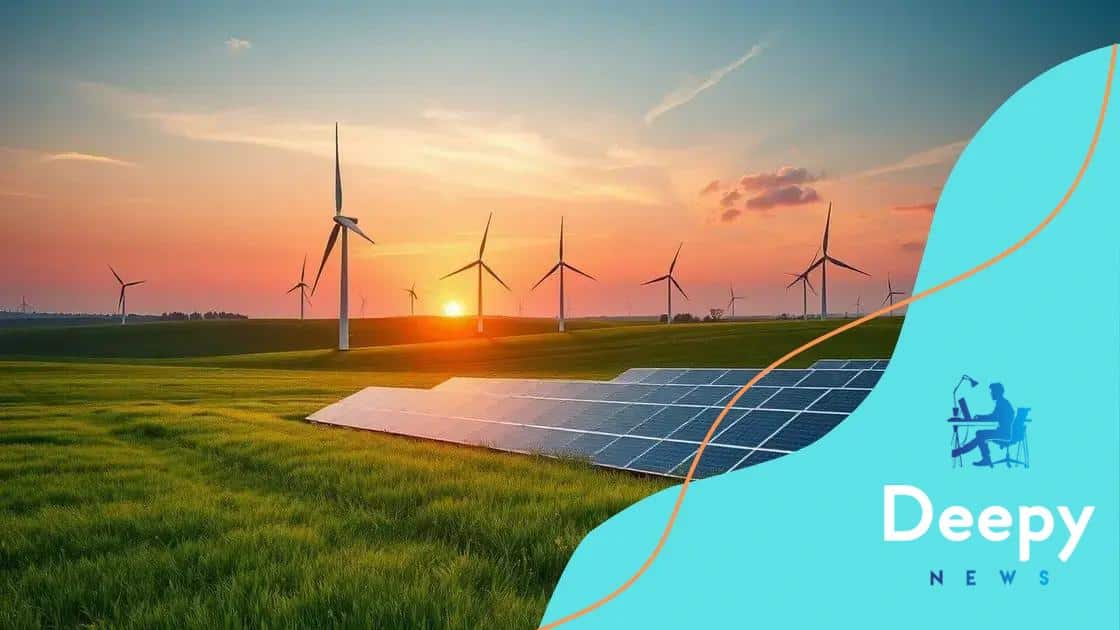The future of clean energy and its technological advancements

The future of clean energy and its technological advancements focus on sustainable practices, emerging technologies, governmental policies, and their significant impact on global markets through job creation and economic growth.
The future of clean energy is not just a topic of discussion; it’s a reality that shapes our world. With rapid advancements in technology, we can explore how these innovations are changing the landscape of energy production and consumption.
Understanding clean energy sources
Understanding clean energy sources is essential in today’s world, where sustainability is becoming a priority. These sources help reduce our carbon footprint and promote a healthier planet.
Clean energy primarily comes from natural processes that are replenished constantly. Among the most important sources are:
Types of Clean Energy Sources
- Solar energy: Captured from sunlight using solar panels, it can power homes and businesses efficiently.
- Wind energy: Generated using wind turbines, this source harnesses the power of the wind to produce electricity.
- Hydropower: Produced by harnessing the energy from flowing water, often from rivers or dams.
- Geothermal energy: Derived from the heat stored beneath the Earth’s surface, this energy can be used for heating and electricity.
These sources not only help in saving on energy costs but also contribute to a cleaner environment. Each of these clean energy sources plays a unique role in the energy landscape.
As technology advances, the efficiency of these sources continues to improve. For example, modern solar panels have become more efficient at converting sunlight into energy, increasing their viability for widespread use. Similarly, wind turbines are being designed to capture more wind energy, making them a more effective option.
In addition to their environmental benefits, utilizing clean energy sources can lead to energy independence. Countries can reduce their reliance on imported fossil fuels by investing in local renewable resources, thus enhancing their energy security.
Furthermore, clean energy projects often create jobs in manufacturing, installation, and maintenance. This transition to renewable energy not only benefits the environment but also boosts the economy by generating employment opportunities in new sectors.
In summary, understanding clean energy sources is crucial for embracing a sustainable future. It allows us to make informed decisions that favor environmental health and economic growth.
Technological innovations in renewable energy
Technological innovations in renewable energy are transforming our approach to sustainability and energy production. These advancements are paving the way for more efficient and effective energy solutions.
One notable area of innovation is energy storage. With improved battery technology, renewable energy sources like solar and wind can store excess energy for use during peak times. This ensures a steady energy supply, even when the sun isn’t shining or the wind isn’t blowing.
Latest Trends in Renewable Energy Technology
- Smart grids: These advanced electricity networks use digital technology to improve reliability and efficiency, allowing for better integration of renewable energy sources.
- Floating solar panels: Utilizing bodies of water, floating solar farms can maximize space and reduce land use while generating clean energy.
- Vertical wind turbines: This innovative design uses less space and is more aesthetically pleasing, making it suitable for urban areas.
- Hydrogen energy: Emerging as a clean fuel alternative, hydrogen production from renewable sources offers potential for long-term energy storage.
As we explore these innovations, it’s crucial to recognize their impact on reducing greenhouse gas emissions. For instance, improved solar panel efficiency has made it more affordable for homeowners to utilize clean energy, leading to a significant increase in installations. Furthermore, advancements in turbine technology are allowing wind farms to generate more energy with less environmental impact.
Collaboration between governments, industries, and researchers is vital for advancing these technologies. Public investments in research and development can accelerate the integration of innovative solutions into the energy market. By fostering an environment of innovation, we can ensure that renewable energy becomes a primary energy source in the future.
Moreover, these technological advancements contribute to job creation in the renewable energy sector. As new technologies require skilled workers for manufacturing, installation, and maintenance, communities often benefit from job growth in this expanding field. Investing in renewable energy technologies not only addresses climate change but also opens up new economic opportunities.
Impact of clean energy on global markets

The impact of clean energy on global markets is significant and continually growing. As more countries embrace renewable resources, they shape economic landscapes and influence energy prices worldwide.
Investing in clean energy is becoming a priority for many nations. This transition is driven by the need to reduce greenhouse gas emissions and combat climate change. As countries commit to reducing their carbon footprint, they are also exploring economic benefits from renewable energy investments.
Economic Benefits of Clean Energy
- Job creation: The shift toward renewable energy generates numerous jobs in manufacturing, installation, and maintenance.
- Energy independence: Countries that develop local clean energy sources can reduce reliance on imported fossil fuels.
- Investment opportunities: Growing clean energy sectors attract investment, creating opportunities for businesses and entrepreneurs.
- Market stability: Renewable energy can reduce price volatility associated with traditional fossil fuels.
As clean energy technologies advance, they reduce operational costs, making renewable power increasingly competitive. For instance, the price of solar panels has dropped dramatically, making solar energy more accessible for both individuals and businesses. This affordability is encouraging widespread adoption and supporting energy transitions in emerging markets.
Governments play a crucial role in shaping clean energy markets. Policies such as tax incentives and subsidies can stimulate growth in renewable sectors. Furthermore, international agreements like the Paris Accord encourage countries to strengthen their clean energy commitments, promoting a collective shift towards sustainability.
The competition among clean energy technologies also drives innovation. New startups are emerging to develop creative solutions, enhancing the efficiency of wind turbines and solar systems. This competition not only fuels technological advancements but also boosts economic growth by fostering a dynamic energy market.
In conclusion, the rising influence of clean energy on global markets is reshaping the economic landscape. By embracing renewable resources, countries can achieve environmental objectives while stimulating their economies.
The role of government policies in clean energy
The role of government policies in clean energy is crucial. These policies help promote and accelerate the transition from fossil fuels to renewable energy sources. Governments around the world are recognizing the importance of creating frameworks that support sustainable energy initiatives.
One major way that governments influence the clean energy market is through financial incentives. For example, many countries provide tax credits or rebates for individuals and businesses investing in solar panels or wind energy systems. These incentives encourage more people to adopt renewable technologies, helping to reduce greenhouse gas emissions.
Types of Government Policies Supporting Clean Energy
- Subsidies: Direct financial support for renewable energy projects can lower the cost of implementation.
- Renewable energy standards: Laws that require a certain percentage of energy to come from renewable sources push utilities to diversify their energy portfolios.
- Grants and loans: Government programs can provide funding to start-ups and established companies focusing on clean energy technologies.
- Research and development funding: Investing in R&D helps accelerate innovation within the renewable energy sector.
In addition to direct financial support, government policies can create a stable regulatory environment. Clear rules and guidelines help businesses plan for long-term investments. When companies know what to expect from regulations, they are more likely to develop new clean energy technologies and expand their operations.
International agreements also play a part in shaping government policies. Treaties like the Paris Agreement encourage nations to set targets for reducing carbon emissions. By committing to these agreements, governments are pushed to develop stronger policies and take significant actions toward clean energy adoption.
Public awareness campaigns led by governments can significantly contribute to increased acceptance and understanding of renewable energy. When people are educated about the benefits and potential of clean energy, they are more likely to support policies that promote implementation.
Future trends in clean energy technology
The future trends in clean energy technology are exciting and hold great promise for a sustainable world. As society increasingly prioritizes environmental responsibility, innovations in technology are expected to shape the way we produce and consume energy.
One major trend is the rise of decentralized energy systems. With advancements in battery storage and solar technology, individuals can generate and store their own energy. This change empowers consumers and reduces reliance on traditional energy grids.
Emerging Technologies in Clean Energy
- Energy storage solutions: New battery technologies, such as solid-state batteries, are improving energy storage capacity and efficiency.
- Smart grid technology: Advanced digital technologies are enabling better energy management, leading to more efficient use of resources.
- Carbon capture and storage (CCS): This technology aims to capture carbon emissions from industrial sources and store them underground, reducing atmospheric pollution.
- Bioenergy advancements: New methods for converting biomass into energy are being developed, enhancing the viability of sustainable energy sources.
In addition to these technologies, the trend toward electrification is expected to grow. This includes converting vehicles and heating systems to electric power, significantly reducing emissions. The surge in electric vehicle (EV) adoption creates demand for renewable energy sources to power these vehicles, leading to a ripple effect in clean energy production.
Research into hydrogen fuel cells is also on the rise. This technology offers a clean alternative for powering vehicles and industries, with water as the only byproduct. As research advances, hydrogen could become a key player in the transition to a hydrogen-based economy.
Moreover, government incentives and worldwide climate goals are accelerating these trends. Countries are committing to ambitious targets for reducing emissions, driving innovation in clean energy technologies. Public and private sectors are collaborating to develop solutions that meet these challenges, ensuring a more sustainable future.
FAQ – Frequently Asked Questions about Clean Energy Technology
What are the main benefits of clean energy technology?
Clean energy technology reduces greenhouse gas emissions, promotes sustainability, and creates job opportunities in renewable sectors.
How does government policy influence clean energy adoption?
Government policies provide financial incentives and create a stable regulatory environment, which encourages investments in renewable energy.
What are the emerging technologies in clean energy?
Emerging technologies include advanced energy storage, smart grids, carbon capture and storage, and improvements in bioenergy.
What impact does clean energy have on global markets?
Clean energy drives economic growth by creating jobs, reducing reliance on fossil fuels, and stabilizing energy prices.
 Clean Energy Impact
Clean Energy Impact Technological Innovations
Technological Innovations Economic Growth
Economic Growth Government Role
Government Role Future Potential
Future Potential





